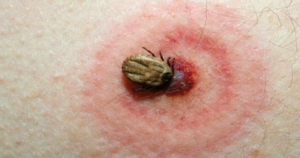Be Aware of Ticks to Prevent Lyme Disease

Photo Credit: Montgomery County Website
Montgomery County health officials are urging residents to learn about Lyme disease and how to protect themselves when they are outdoors.
“As residents begin to spend more time outdoors–whether at parks and trails, sports events or enjoying their own backyard–we want to be sure they protect themselves from tick bites and tickborne diseases, including Lyme disease. Lyme disease has become a serious public health issue in many parts of the United States and it is important for residents to educate themselves and their children so they can prevent Lyme disease and seek treatment quickly if they become infected,” said Dr. Ulder J. Tillman, County Health Officer.
Lyme disease is an illness caused by the Borrellia Burgdorferi bacteria and is caused by the bite of a tick infected with the bacteria. Lyme disease was first recognized in Lyme, Connecticut in 1975 and is most prevalent in the northeast and upper Midwest areas of the United States. The U.S. Centers for Disease Control and Prevention reported 22,561 cases of Lyme disease in 2010. Maryland reported 1,163 cases in 2010. In 2011, Montgomery County had 287 reported cases of Lyme disease .
Symptoms of Lyme disease may include headache, fever, muscle and joint aches, fatigue and a distinctive “bull’s-eye” shaped skin rash. If left untreated, Lyme disease can progress to more serious problems, including joint and muscle swelling and heart disease.
The best defense against Lyme disease is to protect against tick bites. Ticks do not jump or fly onto humans, but wait on low vegetation and attach themselves to hosts (mice, deer, humans) as they walk by.
The following steps will help protect against Lyme disease:
- Avoid tick-infested areas such as tall grass and dense vegetation.
- Walk in the center of mowed trails to avoid brushing against vegetation.
- Keep grass cut and underbrush thinned in yards.
- Follow directions carefully if chemicals are used for tick control or hire a professional.
- Eliminate the living places of small rodents.
- Wear light-colored clothing so that ticks are easier to see and remove.
- Tuck pant legs into socks and boots. Wear long-sleeved shirts buttoned at the wrist. Tuck shirts into pants to keep ticks on the outside of clothing.
- Conduct tick checks on yourself, your children and your pets every four to six hours for several days after you have been in a tick infested area.
- Apply tick repellent to areas of the body and clothing that may come in contact with grass and brush. Repellents include those containing up to 50 percent DEET for adults or less than 30 percent for children. A repellent/pesticide containing 0.5 percent permethrin may be applied to clothing, but should not be used on skin.
- Follow directions carefully and do not overuse repellents. Some tick repellents can cause toxic or allergic reactions.
- Ask your veterinarian to recommend tick control methods for your pets. Animals can get Lyme disease but they do not transmit these diseases to humans. Remember, however, pets can bring ticks into your house.
For more information about Lyme disease, go to www.montgomerycountymd.gov/lymedisease.


Engage us on Facebook
Follow us on Twitter
Tweets by @mymcmedia